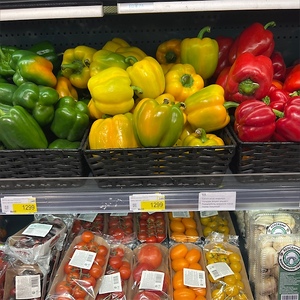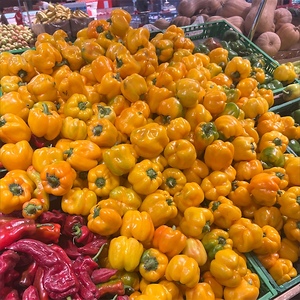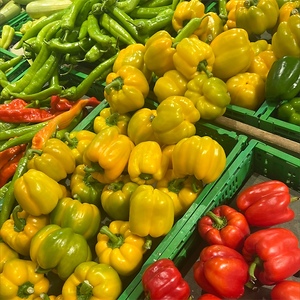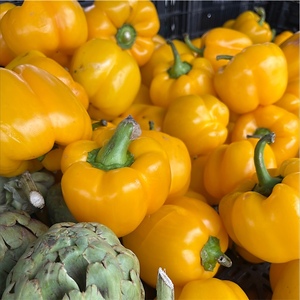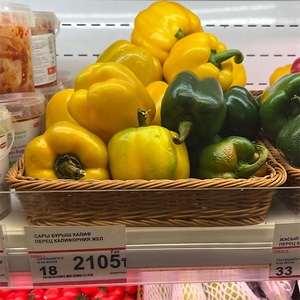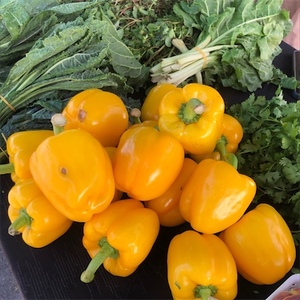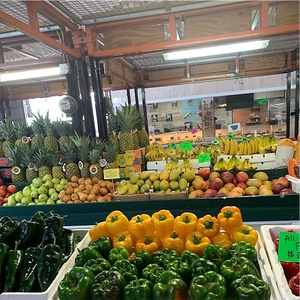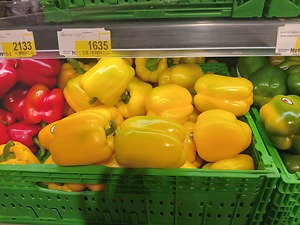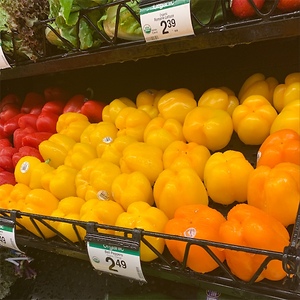


Large Yellow Bell Peppers
Estimated Inventory, 25 lbs : 23.08
This item was last sold on : 07/24/25
Description/Taste
Yellow bell peppers are medium to large in size, averaging seven centimeters in length and five centimeters in diameter, and are rounded, square, and blocky in shape with 3-4 lobes and a thick green stem. The smooth skin is firm, glossy, and pale green when young, transforming to bright yellow with age. Underneath the skin, the vibrant yellow flesh is thick, crisp, and succulent, with a hollow cavity that contains very small, flat and bitter cream-colored seeds and a thin, spongy membrane. Yellow bell peppers are crunchy and juicy with a mild, sweet flavor.
Seasons/Availability
Yellow bell peppers are available year-round, with a peak season in the summer.
Current Facts
Yellow bell peppers, botanically classified as Capsicum annuum, are the sweet, edible fruits of a plant that can be grown both as an annual or perennial and belongs to the Solanaceae or nightshade family. There are several varieties of bell peppers that are grown specifically for their yellow stage of maturity, as temperatures during coloring play a major role in the uniformity and rate of color development. These varieties include Golden Belle, Golden Cal Wonder, Astro, Klondike Bell, Honey Bell, and Marengo. Yellow bell peppers are favored by chefs and home cooks for their sweet flavor, crunchy flesh, and bright color.
Nutritional Value
Yellow bell peppers are an excellent source of vitamin C and also contain vitamin A, fiber, calcium, iron, and potassium.
Applications
Yellow bell peppers are best suited for both raw and cooked applications such as roasting, baking, grilling, and sautéing. The peppers can be used fresh and chopped into salsa, sliced and served on vegetable trays with dips, layered into sandwiches, wraps, and burgers, or diced and tossed into fresh green salads. They can also be roasted and mixed into sauces for pasta or vegetable side dishes, grilled and served with roasted meats, sautéed and mixed into stir-fries, or layered in tacos. Yellow bell peppers pair well with potatoes, onions, garlic, fennel, leeks, spinach, beets, basil, bok choy, tomatoes, saffron, raisins, almonds, pine nuts, sunflower seeds, black sesame seeds, blue cheese, goat cheese, soy sauce, grapefruit vinaigrette, red wine vinegar, béchamel sauce, lentils, sausage, salmon, poultry, eggs, and cornbread. The peppers will keep up to one week when stored unwashed in the crisper drawer of the refrigerator.
Ethnic/Cultural Info
Bell peppers are often thought of as a vegetable, but they are actually a fruit because they contain seeds and grow on a flowering plant. In the United States, the month of November is considered national capsicum or national pepper month and is celebrated by chefs and home cooks to raise awareness and to promote the many different colors of the sweet peppers. Bell peppers are also the only capsicum that does not produce capsaicin, which is the chemical that causes the brain to think the pepper is hot or spicy.
Geography/History
Yellow bell peppers are native to tropical America and have been growing since ancient times. They were then introduced to Asia and Europe via Spanish and Portuguese explorers around 1493, and since then new varieties and heirloom varieties have been cultivated across the world. Today Yellow bell peppers can be found at supermarkets, farmers markets, specialty grocers, and grown in home gardens in North America, Central America, South America, Africa, Europe, Asia, and Australia.
Featured Restaurants
Restaurants currently purchasing this product as an ingredient for their menu.
| Cocina de Barrio Encinitas | Encinitas CA | 760-840-1129 |
| Tribute Pizza | San Diego CA | 858-220-0030 |
| Jo's Mission Hills Diner | San Diego CA | 619-417-3801 |
| Extraordinary Desserts Union St. | San Diego CA | 619-294-7001 |
| Fresh Sushi Catering | Carlsbad CA | 858-344-7098 |
| Pamplemousse Grill | Solana Beach CA | 858-792-9090 |
| Madison | San Diego CA | 619-822-3465 |
| Coco Maya by Miss Bs | San Diego CA | 858-245-3780 |
| Barleymash | San Diego CA | 619-255-7373 |
| Little Frenchie | Coronado CA | 619-522-6890 |
| Pacifica Del Mar | Del Mar CA | 858-792-0505 |
| Toast Catering | San Diego CA | 619-795-9135 |
| Rosewood Social | San Juan Capistrano CA | 669-243-8403 |
| Sugar Bear Enterprises | San Diego CA | 925-383-3623 |
| The Haven (Pizzeria) | San Diego CA | 619-964-3778 |
| Miguel's Cocina Carlsbad | Carlsbad CA | 760-759-1843 |
| WineSellar & Brasserie | San Diego CA | 858-450-9557 |
| Pacific Terrace Hotel | San Diego CA | 858-581-3500 |
| Pacific Regent La Jolla | San Diego CA | 858-597-8008 |
| Chef Lance Roll | Vista CA | 760-685-2433 |
| La Valle Coastal Club | Rancho Santa Fe CA | 858-759-5473 |
| Carolines Seaside Cafe | La Jolla CA | 619-646-1481 |
| Lodge at Torrey Pines Main | San Diego CA | 858-453-4420 |
| Plant Based Meals | San Diego CA | 858-255-0590 |
| The Switchboard Restaurant 2024 | Oceanside CA | 760-279-6300 |
| Shoreside Support Boat | San Diego CA | 704-277-7929 |
| Trust Restaurant | San Diego CA | 609-780-7572 |
| Salt and Lime | Del Mar CA | 858-926-8582 |
| The Crossings | Carlsbad CA | 760-444-1800 |
| Living Coast Discovery Center | Chula Vista CA | 619-409-5900 |
| Trattoria I Trulli | Encinitas CA | 760-277-9826 |
| Miguel's Old Town | San Diego CA | 619-298-9840 |
| Common Theory Chula Vista | Chula Vista CA | 619-495-3689 |
| Bang on 5th | San Diego CA | 619-677-5650 |
| Royal Polaris Sportfishing | San Diego CA | 619-226-8030 |
| Sheraton Carlsbad (7 Mile) | Carlsbad CA | 760-827-2400 |
| Bar Ella | San Diego CA | 858-808-2286 |
| SIE Culinary Management | San Diego CA | 858-964-8677 |
| Crown Point Catering | San Diego CA | 619-223-1211 |
| Fresco Cocina | Carlsbad CA | 760-720-3737 |
| Extraordinary Desserts | San Diego CA | 619-294-2132 |
| Pizza Cassette | San Diego CA | 802-310-5601 |
| Culinary Concepts | San Diego CA | 619-865-1918 |
| Pitchers | San Diego CA | 858-472-1251 |
| Golden Door | San Marcos CA | 760-761-4142 |
| Green Dragon Tavern & Museum | Carlsbad CA | 760-797-5579 |
| Casero Taqueria | Carlsbad CA | 760-533-4997 |
| Kona Kai Resort and Marina | San Diego CA | 619-221-8000 |
| Mille Fleurs | Rancho Santa Fe CA | 858-756-3085 |
| Common Theory | San Diego CA | 858-384-7974 |
| The Handmade Chef Meal Prep Co. | San Diego CA | 619-368-3705 |
| Piatti | San Diego CA | 858-454-1589 |
| Cliffhanger Cafe Menu | San Diego CA | 858-452-9858 |
| Hasta Manana Cantina | San Diego CA | 619-276-6700 |
| The Market by Buon Appetito | San Diego CA | 619-237-1335 |
| Il Giardino di Lilli | La Jolla CA | 619-467-9897 |
| Miguel's 4S Ranch | San Diego CA | 858-924-9200 |
| 619 Spirits | San Diego CA | 509-701-9534 |
| Sandpiper Wood Fired Grill & Oysters | La Jolla CA | 858-228-5655 |
| Kairoa Brewing Company | San Diego CA | 858-735-0051 |
| Wildland | Carlsbad CA | 619-385-0914 |
| Herb & Wood | San Diego CA | 520-205-1288 |
| LANA | Solana Beach CA | 602-758-2596 |
| Farm Fresh Meals | Vista CA | 760-707-2383 |
| Ballast Point Rest. - Miramar | San Diego CA | 858-790-6900 |
| Polaris Supreme | San Diego CA | 619-390-7890 |
| UCSD Food & Nutrition Department La Jolla | San Diego CA | 858-761-1269 |
| Giuseppe Restaurants & Fine Catering | San Diego CA | 619-436-7006 |
| Bali Hai Restaurant | San Diego CA | 619-222-1181 |
| Turf Supper Club | San Diego CA | 619-234-6363 |
| Belmont Park Draft | San Diego CA | 858-228-9283 |
| Elks Lodge 2698 -Donation | Lakeside CA | 619-390-4949 |
| Sensations Salud | San Diego CA | 619-933-3489 |
| US Grant Hotel Grill | San Diego CA | 619-232-3121 |
| The Beau Hotel | San Diego CA | 619-310-5160 |
| C 2 C | San Diego CA | 619-972-9345 |
| Alila Marea Beach Resort | Encinitas CA | 805-539-9719 |
| Mavericks Beach Club | San Diego CA | 858-999-0348 |
| Institutes of Health LLC | San Diego CA | 800-270-5016 |
| Urban Kitchen Catering | San Diego CA | 619-276-8803 |
| PureTaco | Carlsbad CA | 760-845-3346 |
| Callie | San Diego CA | 619-947-9036 |
| Ciccia Osteria | San Diego CA | 619-674-4069 |
| Hotel La Jolla - Sea & Sky | La Jolla CA | 858-459-0261 |
| Viejas Casino TMDR | Alpine CA | 619-659-1774 |
| BFD-Big Front Door | San Diego CA | 619-723-8183 |
| Bernardo Heights Country Club | San Diego CA | 858-487-4022 |
| Reata Glen | Ladera Ranch CA | 949-545-2250 |
| Cocina de Barrio NP | San Diego CA | 858-349-2313 |
| Bencotto Italian Kitchen | San Diego CA | 619-822-5493 |
| Parkhouse Eatery | San Diego CA | 619 295 7275 |
| Blue Ocean Sushi & Grill (UTC) | San Diego CA | 858-886-9909 |
| University Club | San Diego CA | 619-234-5200 |
| Marriott Gaslamp | San Diego CA | 619-696-0234 x6051 |
| Miguel's Cocina Pt Loma | San Diego CA | 619-224-2401 |
| Miguel's Cocina Coronado | Coronado CA | 619-437-4237 |
| Pacific Coast Grill | Solana Beach CA | 858-794-4632 |
| La Bonne Table | San Diego CA | 619-887-7706 |
| Bica | San Diego CA | 619-669-5725 |
| Cocina De Barrio | San Diego CA | 760-840-1129 |
| Barbarella La Jolla | La Jolla CA | 858-454-7373 |
| The Guild Hotel | San Diego CA | 619-764-5108 |
| Tartine | Coronado CA | 619-435-4323 |
| Scion Health | Escondido California | 442-277-6167 |
| Redwing Bar & Grill | San Diego CA | 619-281-8700 |
| Nolita Hall | San Diego CA | 619-618-8820 |
| Coast Catering | Escondido CA | 619-295-3173 |
| Crudo Cevicheria & Oyster Bar | San Diego CA | 619-313-9127 |
| Cape Rey Carlsbad, a Hilton Resort | Carlsbad CA | 760-602-0800 |
| Boujiemana | San Diego CA | 415-710-0510 |
| Hash House A Go Go | San Diego CA | 951-764-0605 |
| Lilo NA | Carlsbad CA | 619-385-0914 |
| Coral Del Mar | Del Mar CA | 858-449-6679 |
| PFC Fitness Camp | Carlsbad CA | 888-488-8936 |
| Le Coq (Bar) | La Jolla CA | 858-427-1500 |
| Red Tail Catering | San Marcos CA | 858-605-8219 |
| El Sueno | San Diego CA | 619-972-6286 |
| American Pizza Manufacturing | La Jolla CA | 858-246-6756 |
| Rancho Santa Fe Golf Club | Rancho Santa Fe CA | 858-756-1582 |
| Del Mar Country Club | Rancho Santa Fe CA | 858-759-5995 |
| Parisien Gourmandises | La Jolla CA | 858-352-6552 |
| Cutwater Spirits | San Diego CA | 619-672-3848 |
| Sisters Pizza | San Diego CA | 858-228-6822 |
| Coin-Op Game Room (Downtown) | San Diego CA | 619-255-8864 |
| insideOUT | San Diego CA | 619-888-8623 |
| Bridges at Rancho Santa Fe | Rancho Santa Fe CA | 858-759-6063 |
| US Grant Hotel Main | San Diego CA | 619-232-3121 |
| Bishop School | San Diego CA | 858-459-4021 |
| Nobu | San Diego CA | 619-814-4124 |
| Portside Pier (Miguels) | San Diego CA | 858-268-1030 |
| Margaritaville Hotel SD (Kitchen) | San Diego CA | 619-819-9500 |
| Campfire | Carlsbad CA | 760-637-5121 |
| Cal A Vie | Vista CA | 760-945-2055 |
| Blue Ocean | Carlsbad CA | 760-434-4959 |
| Cork & Stem LLC | San Diego CA | 619-354-0308 |
| Sago | Encinitas CA | 858-382-4047 |
| Wormwood | San Diego CA | 619-573-0289 |
| Coronado Yacht Club | Coronado CA | 619-435-1848 |
| The Country Club Of Rancho Bernardo | San Diego CA | 858-487-1134 |
| Flora Cafe | Bonita CA | 619-339-6604 |
| Cocina de Barrio Point Loma | San Diego CA | 858-349-2313 |
| Mission Bay Beach Club | San Diego CA | 858-201-7551 |
| Sushi Nekosan | La Jolla CA | 858-999-0999 |
| Third Corner Encinitas | Encinitas CA | 760-942-2104 |
| Food by Chef Ty | Vista CA | 424-278-8626 |
| Sepulveda Meats & Provisions | San Diego CA | 619-501-1878 |
| The Harvest Honey | San Marcos CA | 616-914-0124 |
| InterContinental Vistal Kitchen | San Diego CA | 619-501-9400 |
| Bread & Cie Café | San Diego CA | 619-683-9322 |
| Storyhouse Spirits Bar | San Diego CA | 801-949-5955 |
| Ridgeview Health Center | San Diego CA | 858-293-3950 |
| Rancho Valencia | Del Mar CA | 858-756-1123 |
| Bayside Landing | San Diego CA | 858-270-9200 |
| Searcher Sportfishing | San Diego CA | 619-861-4640 |
Recipe Ideas
Recipes that include Large Yellow Bell Peppers. One



